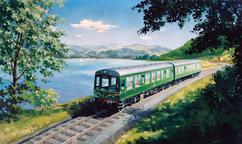

Colour print, Travelling on the Liverpool & Manchester Railway 1831, Plate I: A Train of First Class Carriages with the mail, hauled by "Jupiter". Plate II: A train of Second Class Carriages for outside passengers with three Third Class carriages behind, hauled by "North Star". Text:- "North Star built 1830 by R.Stephenson and Co., 11" Cylinders, 16"Stroke, 5ft.Driving wheel. "Jupiter" built 1831 by R. Stephenson and Co., 11"Cylinders, 16"Stroke, 5ft Driving wheel. The 1st and 2nd Class carriages were constructed after the style of three stage coach bodies combined to form one carriage. The Guard rode on the top of the front carriage and directed the Engine Driver, whilst the Royal Mail Man guarded the maia in the rear. G. Leeman Esq., Chairman of the North Eastern Railway speaking as Chairman of the First Railway Jubilee (Stockton & Darlington) held at Darlington 27th Sept. 1875, said, "I know nothing comparable in the History of Science to that grand triumphal march - for such it was - with which the Liverpool and Manchester Railway was opened". Printed by Raphael Tuck, copyrighted by M B Cotsworth, Holgate, York, 1894.
This 1894 lithograph depicts two trains of carriages on the Liverpool and Manchester Railway in 1831. The upper train is pulled by the steam locomotive Jupiter (built 1831), while the lower train is pulled by North Star (built 1830). When the Liverpool and Manchester Railway opened in 1830 it was the first steam-powered inter-city railway in the world, running for 50km between the two cities. The railway’s chief engineer was George Stephenson (1781-1848).
The lower train shows second- and third-class carriages without roofs. While this was true in the early days of the railway, in August 1831 roofs were fitted to second-class carriages after passengers complained that falling cinders burned their clothing.
The publication of this print 64 years after the opening of the Liverpool and Manchester Railway demonstrates the continued cultural interest in the early railway. The print continues a tradition which began in 1830 of illustrating the railway in commemorative objects such as prints, mugs, bowls, and medals.
Details
- Category:
- Pictorial Collection (Railway)
- Object Number:
- 2000-7771
- Measurements:
-
: 11.4173 x 26.7717 in.; 290 x 680 mm
- type:




